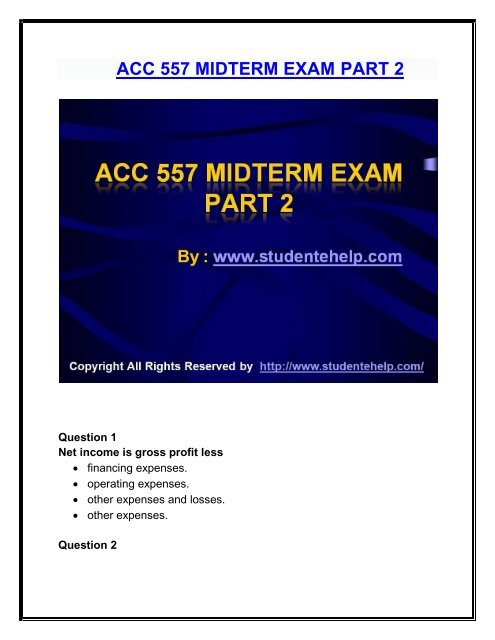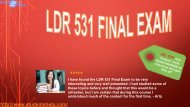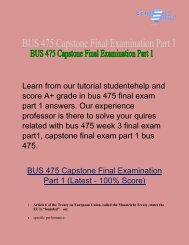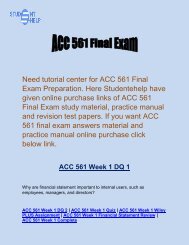ACC 557 Midterm Exam Part 2 Assignment
Touch and feel the brilliance with ACC 557 Midterm Exam Part 2 Strayer University Assignments and feel the positive changes in you.
Touch and feel the brilliance with ACC 557 Midterm Exam Part 2 Strayer University Assignments and feel the positive changes in you.
You also want an ePaper? Increase the reach of your titles
YUMPU automatically turns print PDFs into web optimized ePapers that Google loves.
<strong>ACC</strong> <strong>557</strong> MIDTERM EXAM PART 2<br />
Question 1<br />
Net income is gross profit less<br />
financing expenses.<br />
operating expenses.<br />
other expenses and losses.<br />
other expenses.<br />
Question 2
On November 2, 2014, Kasdan Company has cash sales of $6,000<br />
from merchandise having a cost of $3,600. The entries to record the<br />
day's cash sales will include:<br />
a $3,600 credit to Cost of Goods Sold.<br />
a $6,000 credit to Cash.<br />
a $3,600 credit to Inventory.<br />
d a $6,000 debit to Accounts Receivable.<br />
Question 3<br />
Glenn Company purchased merchandise inventory with an invoice<br />
price of $9,000 and credit terms of 2/10, n/30. What is the net cost of<br />
the goods if Glenn Company pays within the discount period?<br />
$8,100<br />
$8,280<br />
$8,820<br />
$9,000<br />
Question 4<br />
When a seller grants credit for returned goods, the account that is<br />
credited is<br />
Sales Revenue.<br />
Sales Returns and Allowances.<br />
Inventory.<br />
Accounts Receivable.<br />
Question 5<br />
An aging of a company's accounts receivable indicates that $14,000<br />
are estimated to be uncollectible. If Allowance for Doubtful Accounts<br />
has a $1,100 credit balance, the adjustment to record bad debts for<br />
the period will require a<br />
debit to Bad Debt Expense for $14,000.<br />
debit to Allowance for Doubtful Accounts for $12,900.<br />
debit to Bad Debt Expense for $12,900.<br />
credit to Allowance for Doubtful Accounts for $14,000.
Find the Complete exam answers click here <strong>ACC</strong> <strong>557</strong> Week 1<br />
Complete<br />
Question 6<br />
The basic issues in accounting for notes receivable include each of<br />
the following except<br />
analyzing notes receivable.<br />
disposing of notes receivable.<br />
recognizing notes receivable.<br />
valuing notes receivable.<br />
Question 7<br />
Three accounting issues associated with accounts receivable are<br />
depreciating, returns, and valuing.<br />
depreciating, valuing, and collecting.<br />
recognizing, valuing, and disposing.<br />
accrual, bad debts, and disposing.<br />
Question 8<br />
A cash discount is usually granted to all of the following except<br />
retail customers.<br />
retailers.<br />
wholesalers.<br />
All of these answers are correct.<br />
Question 9<br />
If a company fails to record estimated bad debts expense,<br />
cash realizable value is understated.<br />
expenses are understated.<br />
revenues are understated.<br />
receivables are understated.
Question 10<br />
Bad Debt Expense is considered<br />
an avoidable cost in doing business on a credit basis.<br />
an internal control weakness.<br />
a necessary risk of doing business on a credit basis.<br />
avoidable unless there is a recession.<br />
Want to download the Complete <strong>Assignment</strong>s of <strong>ACC</strong> <strong>557</strong>….?? Click<br />
<strong>ACC</strong> <strong>557</strong> Complete <strong>Assignment</strong><br />
Question 11<br />
The collection of an account that had been previously written off<br />
under the allowance method of accounting for uncollectibles<br />
will increase income in the period it is collected.<br />
will decrease income in the period it is collected.<br />
requires a correcting entry for the period in which the account was<br />
written off.<br />
does not affect income in the period it is collected.<br />
Question 12<br />
The maturity value of a $50,000, 9%, 60-day note receivable dated July<br />
3 is<br />
$50,000.<br />
$50,750.<br />
$54,500.<br />
$59,000.<br />
Question 13<br />
The control principle related to not having the same person authorize<br />
and pay for goods is known as<br />
establishment of responsibility.<br />
independent internal verification.<br />
segregation of duties.<br />
rotation of duties.
Question 14<br />
If the month-end bank statement shows a balance of $54,000,<br />
outstanding checks are $15,000, a deposit of $6,000 was in transit at<br />
month end, and a check for $900 was erroneously charged by the<br />
bank against the account, the correct balance in the bank account at<br />
month end is<br />
$44,100.<br />
$45,000.<br />
$45,900.<br />
$62,100.<br />
Question 15<br />
A system of internal control<br />
is infallible.<br />
can be rendered ineffective by employee collusion.<br />
invariably will have costs exceeding benefits.<br />
is premised on the concept of absolute assurance.<br />
Want to see the answers of <strong>ACC</strong> <strong>557</strong> <strong>Midterm</strong> <strong>Exam</strong> click…..?? <strong>ACC</strong><br />
<strong>557</strong> <strong>Midterm</strong> <strong>Exam</strong><br />
Question 16<br />
A credit balance in Cash Over and Short is reported as a(n)<br />
asset.<br />
liability.<br />
miscellaneous expense.<br />
miscellaneous revenue.<br />
Question 17<br />
The cash account shows a balance of $40,000 before reconciliation.<br />
The bank statement does not include a deposit of $9,200 made on the<br />
last day of the month. The bank statement shows a collection by the
ank of $3,960 and a customer’s check for $1,300 was returned<br />
because it was NSF. A customer’s check for $1,380 was recorded on<br />
the books as $1,920, and a check written for $318 was recorded as<br />
$390. The correct balance in the cash account was<br />
$42,048.<br />
$42,192.<br />
$43,128.<br />
$51,392.<br />
Question 18<br />
A petty cash fund of $100 is replenished when the fund contains $4 in<br />
cash and receipts for $93. The entry to replenish the fund would<br />
credit Cash Over and Short for $3.<br />
credit Miscellaneous Revenue for $3.<br />
debit Cash Over and Short for $3.<br />
debit Miscellaneous Expense for $3.<br />
Question 19<br />
Jolene is warehouse custodian and also maintains the accounting<br />
record of the inventory held at the warehouse. An assessment of this<br />
situation indicates<br />
documentation procedures are violated.<br />
independent internal verification is violated.<br />
segregation of duties is violated.<br />
establishment of responsibility is violated.<br />
Question 20<br />
Having one person post entries to accounts receivable subsidiary<br />
ledger and a different person post to the Accounts Receivable Control<br />
account in the general ledger is an example of<br />
inadequate internal control.<br />
duplication of effort.<br />
external verification.<br />
segregation of duties.
Click here to download the complete class of <strong>ACC</strong> <strong>557</strong><br />
Question 21<br />
Which of the following statements is correct with respect to<br />
inventories?<br />
The FIFO method assumes that the costs of the earliest goods<br />
acquired are the last to be sold.<br />
It is generally good business management to sell the most recently<br />
acquired goods first.<br />
Under FIFO, the ending inventory is based on the latest units<br />
purchased.<br />
FIFO seldom coincides with the actual physical flow of inventory.<br />
Question 22<br />
In a manufacturing business, inventory that is ready for sale is called<br />
raw materials inventory.<br />
work in process inventory.<br />
finished goods inventory.<br />
store supplies inventory.<br />
Question 23<br />
Two companies report the same cost of goods available for sale but<br />
each employs a different inventory costing method. If the price of<br />
goods has increased during the period, then the company using<br />
LIFO will have the highest ending inventory.<br />
FIFO will have the highest cost of good sold.<br />
FIFO will have the highest ending inventory.<br />
LIFO will have the lowest cost of goods sold.<br />
Question 24
Indrisano's Used Cars uses the specific identification method of<br />
costing inventory. During March, Indrisano purchased three cars for<br />
$12,000, $14,400, and $19,200, respectively. During March, two cars<br />
are sold for a total of $34,600. Indrisano determines that at March 31,<br />
the $14,400 car is still on hand. What is Indrisano’s gross profit for<br />
March?<br />
$1,000.<br />
$3,400.<br />
$4,200.<br />
$8,200.<br />
Question 25<br />
A company purchased inventory as follows:<br />
150 units at $5<br />
350 units at $6<br />
The average unit cost for inventory is<br />
$5.00.<br />
$5.50.<br />
$5.70.<br />
$6.00.<br />
About Author:<br />
This article covers the topic for the Strayer University <strong>ACC</strong> <strong>557</strong> <strong>Midterm</strong><br />
<strong>Exam</strong> <strong>Part</strong> 2. The author is working in the field of education from last 5<br />
years. This article covers the questions & answers of <strong>ACC</strong> <strong>557</strong> Complete<br />
Course from Strayer University. Other topics in the class are as follows:<br />
<strong>ACC</strong> <strong>557</strong> Week 1 DQ 1
<strong>ACC</strong> <strong>557</strong> Week 1 Homework<br />
<strong>ACC</strong> <strong>557</strong> Week 1 Complete<br />
<strong>ACC</strong> <strong>557</strong> <strong>Midterm</strong> <strong>Exam</strong> <strong>Part</strong> 1<br />
<strong>ACC</strong> <strong>557</strong> <strong>Midterm</strong> <strong>Exam</strong> <strong>Part</strong> 2<br />
Want to check other classes..?? Visit http://www.studentehelp.com/

















